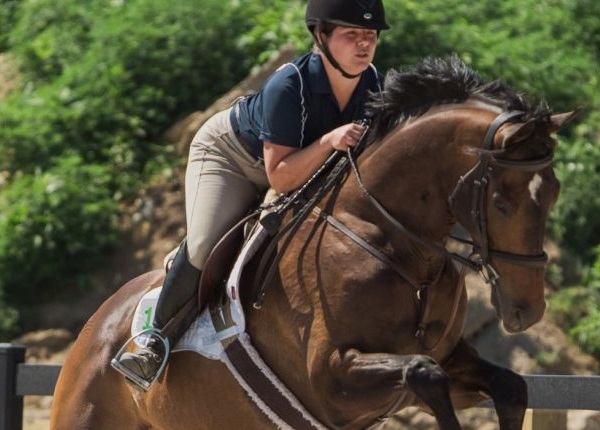By: Keith McCalmont
It wasn’t quite love at first sight for Tizno and his owner, Bernadette Graham.
In October 2019, the 34-year-old Graham, who manages a medical office in Norfolk, Connecticut, was visiting friends and window shopping for a new ride at Akindale Thoroughbred Rescue in Pawling, New York, when she passed by the then 7-year-old gelding’s stall and he rebuffed her friendly overtures.
“He tried to bite me,” said Graham with a laugh. “He’s a bit of a grouch in his stall.”
Fast forward a few weeks later to the Equine Affaire in Massachusetts – an exposition and gathering for the equine community – and Tizno had his second chance to make a first impression when Graham was offered a trial ride in a busy schooling ring.
“Tizno was certainly a love-at-first-ride horse for me. I knew by the second lap at the trot that this was my horse,” Graham said. “Tizno has a lot of presence. He’s a big horse that moves quite well and is super athletic. When I sat on him, I could tell he had a great mind and enjoys working and learning.”
Sired by 2008 Grade 1 Travers-winner Colonel John, the 17-hands tall Tizno is out of the multiple stakes-winning New York-bred mare No Reason, who in 2006 won the NYSSS Park Avenue at Aqueduct, the NYSSS Cupecoy’s Joy and Iroquois Handicap at Belmont Park and the New York Oaks at Finger Lakes.
Tizno competed at all three New York Racing Association, Inc. (NYRA) tracks in a brief four-race career for trainer Randi Persaud. Unfortunately, his impressive breeding didn’t translate to racing success, with his best result a fifth, via disqualification, in his final start on September 22, 2017 at Belmont Park.
When it came time to transition Tizno off the track, the sizable bay was assessed by Rick Schosberg, a veteran NYRA trainer who oversees the New York Thoroughbred Horsemen’s Association’s TAKE THE LEAD (TTL) program.
The TTL program provides preliminary vet exams and treatment, as well as costs related to transportation and rehabilitation or retraining. With the help of Schosberg, TTL was able to place Tizno at Akindale Thoroughbred Rescue in October 2017.
“We try and get horses from a situation where they’re not competitive and not happy into a place like Akindale where they can find a life that’s more amenable to their needs,” said Schosberg. “For him to find a forever home with a new rider and a new vocation for what really is the longer part of his life to enjoy is great. More than 75 percent of their lifespan is in a second career. So, when I hear a cool story like this it gives me a good feeling about the program.”

Tizno flourished on arrival at Akindale Thoroughbred Rescue, a Thoroughbred Aftercare Alliance-accredited [TAA] program, whose motto is ‘reinventing racehorses.’ The NYRA and its horsemen are committed supporters of the TAA, which accredits, inspects, and awards grants to approved aftercare organizations using industry-wide funding.
Every owner competing at NYRA racetracks donates $10 per start to the TAA, which funds the aftercare organizations that provide homes for retired racehorses. New York’s horsemen also donate 1.5 percent of the purchase price of every horse claimed at a NYRA track to TTL and the TAA.
Monique Coston, who works as a trainer at Akindale Thoroughbred Rescue overseeing the rehabilitation of the 120 retirees in the facility’s care, said downtime is the first step to a new life for retired thoroughbreds.
“All horses who enter our program are given 60 days of rest and have some let-down time before they enter our retraining program,” said Coston. “This gives them enough time to get acclimated to life outside the track and time for me to get to know them a bit better.”
Coston said Tizno quickly demonstrated a desire to pick up a new trade.
“Mentally, he really thrived when I put him back into work. I think he was bored before,” Coston said. “Once he was into work and had a solid routine, he became much more focused on what you wanted from him and definitely matured.
“Physically, he was always a big boy who was filled out,” continued Coston. “He looked like a million bucks, but when he went back into work you could tell he didn’t really know how to use his legs. He had to figure out what to do with all of the power and that took some time.”
Once adjusted to his new routine, Coston said Tizno made it clear that he was destined to be a show jumper.
“From the very first cross rail I took him over, he made it very well known that he was meant to jump,” said Coston. “He was super willing to the jumps from an early stage and was very careful from day one. He probably was a bit too careful to be an eventer, and a bit too exuberant to be a great hunter. Show jumping was 100 percent his calling.”
With his training going well, all that was left for Coston was to help Tizno find a forever home that suited his talents and would allow him to grow and thrive. And then along came Graham, a lifelong equestrian with a wealth of experience and a goal of riding competitively in the amateur jumping ranks.
Coston said Tizno and Graham were a perfect match and the adoption came to fruition in November 2019.
“I always tell people to choose the horse that is best for you today, not tomorrow,” said Coston. “You don’t need a reason to fall in love with a particular horse, but you need to love that horse from Day One. When Bernadette fell in love with Tizno, she was already looking at another horse of mine and when she saw Tizno, for whatever reason, that was the horse that made everything click.
“Sometimes you just have to go with your instincts,” continued Coston. “Along with Bernadette being a great rider already, I knew that she would listen to my advice and take her time producing him and the results are the proof. He isn’t the easiest horse to ride and she’s done a great job with him.”

Relationships are hard work. It took Graham and Tizno time to develop the trust and understanding required to be successful.
“Tizno is a very talented jumper but when I first got him he could kind of scare himself with it,” recalled Graham, who lives in Norfolk with her husband, Jim, and their two dogs. “He’d jump straight up and down, which was impressive because we knew he could jump the big jump, but he’d always try and overjump the fences.”
Graham has been riding horses since she was 5-years-old and has tried everything from eventing to hunter-jumpers and even spent time at Yellowstone Park taking people on wagon and trail rides. Graham had most recently worked with a hunter-type horse and she said learning how to communicate with Tizno became a big part of their development.
“It took a good nine months for us to really click over fences and figure each other out,” said Graham. “He worked hard for me and we kept things really small for a long time, working on his flat work and getting his confidence up. He’s the type of horse you could rush because he has a big jump but then he might have backed off and not be so bold as he is now. He had to figure it out in his own time and figure out his legs.”
Graham said she has helped develop Tizno’s style in the ring from that of a robust athlete to a more artistic approach.
“At first, going to the jump he’d tense up – not super quick – but tense and then jump straight up and down instead of in a big arc over it like he does now,” said Graham. “He’d jump so high he’d land and kinda scoot away from the fence, but he’s improving. Sometimes now we’ll celebrate with a little bucking after when he feels like he did a good job.”
Graham, who stands 5’2″, said she adjusted her riding style due to Tizno’s tall build.
“I’m really short,” said Graham. “I was not looking for a horse that big but I’m a pretty brave rider and compatibly wise he needed someone who could keep up with that big jump of his and I’m pretty sticky.
“In fact, the saddle fitter is coming out today, so I can get more of a forward flap in the saddle which will help me when we’re jumping bigger fences,” she added. “My legs don’t come down very far. When you look at the pictures, I’ve got a good couple inches where the bottom of his belly is.”
Perhaps it’s a case of opposites attract, but Graham said the little and large combo is working for them.
“I ride pretty short because he jumps so hard and I have to really put some weight in my stirrups,” said Graham. “He’s short backed so he’s not a long horse from front to end and that makes it easier for someone my height.”
And just like in human relationships, communication is key.
“I figured out the ride he needed and he figured out what I was asking and now we have a good rapport,” said Graham. “I find he takes me to fences a little more now. He’s a little happier about it. He’s just more keen on the job and he’ll flick his ears as we go around and I don’t have to pull or kick as hard or use my leg as much. It just comes together as we go around the course.”

Graham and Tizno, currently jumping at a 0.8 meter level, have their eye on reaching new heights in 2021.
“My ultimate goal would be to compete in the 1.10 m jumpers and go to The Marshall and Sterling finals,” said Graham, referring to an annual showcase held in Saugerties, New York. “I would also like to compete Tizno in the Take2 thoroughbred jumper classes.”
The TAKE2 Second Career Thoroughbred Program, which is sponsored by NYTHA and co-founder New York Thoroughbred Breeders Inc., as well as supporters from the racing and breeding industries, funds prize money in hunter and jumper divisions restricted to thoroughbreds that are eligible to be registered with The Jockey Club. The program includes $10,000 in year-end high-score awards and the $20,000 TAKE2 Hunter & Jumper Finals.
A show jumping course is vastly different to what Tizno experienced as a racehorse.
“Typically there’s eight to 12 fences in a course,” explained Graham. “Each class is a little different. Some are set up to see who can get around clear the fastest, while some are one round and then a jump off. Typically, in those competitions there’s more fences and a regular timed round.”
While speed still matters in the show jumping world, Graham explains that being able to clear the jumps efficiently is key – and that’s a talent Tizno has demonstrated in spades.
“There are penalties if we knock a jump down or if he refuses at one,” said Graham “We don’t get judged on how we look. It’s just get around and leave the jumps up.”
Completing a course takes about one minute and Graham said it’s quite the ride.
“As I go through the corners, I use my legs to steer him quite a bit and help push him into and then out of the corners,” said Graham. “As we come to a jump I have to consider the distance to the fence – if it’s short I put in more contact with the reins and leave leg contact on so he collects his stride more and he gets there at a better distance. At a longer distance, I’d leg him up to it and not quite as much hand.”
It sounds like a lot of work – and it is – but Graham said she loves the experience and the shared communication with Tizno.
“I’ll tell him he’s a good boy if we jump well or if I make a mistake and he carries me through it,” said Graham. “It’s mostly leg commands, setting your body up correctly and using your core. We’ll do four rounds at each show and by the end of it I know he’s not as tired I am.”
And even though he didn’t have his picture taken at the track, Graham is happy to report Tizno is already a winner in the show jumping world.
“He got his first tri-color ribbons this summer and he won a couple of divisions,” said Graham. “It’s not always about the ribbon but it’s nice when we get them. What I really like is a course that feels good and when every jump you land feels great.”
Graham said Tizno has proven to her that retired racehorses will readily adapt to a new life off the track.
“I think thoroughbreds can do any job after the track. They just have to find their niche,” said Graham. “They’re very good jumpers and they have a lot of heart and they’re sure a lot of fun to jump around.”
When not in training, Tizno gets to enjoy being a horse and hanging out in the paddock with Ben, an appendix quarter horse, and his stall neighbor Dixie, a warmblood who has warmed up to the former racehorse.
“He loves to roll and he loves his turnout time,” said Graham, who spoils Tizno with carrots and German Horse Muffins. “He’s lucky to have a giant stall which is 12 X 14. He’s got it pretty made.”
And as much as he enjoys having his own space, Tizno is even learning to enjoy the love and attention he receives from Graham.
“In the stall he’s a bit of a grouch. I don’t think that will leave him. That’s his space and it’s who he is,” Graham said. “But when I get him out of the stall he’s sweet and cuddly, even if he makes faces when I sing to him and hug him.”
Photo: Chelsea Lothrop Photo














